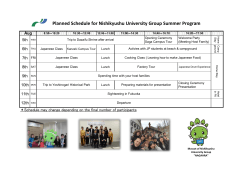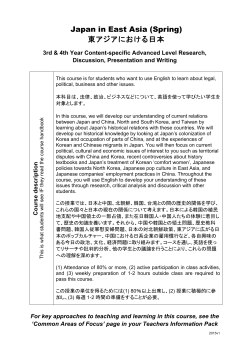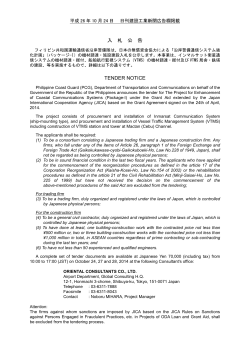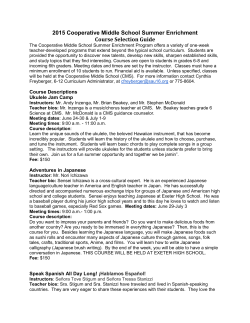
Japanese Aesthetics ï¼»PDF 137KBï¼½
For students enrolled in or before 2014 K0117 Japanese Aesthetics 2 credits Spring 2015 INSTRUCTOR: Hillary Pedersen EMAIL: hillyped26@yahoo.co.jp Course Description Japanese Aesthetics is a seminar-style course that identifies certain sensory reflections in visual, literary and performing arts and culture, and analyzes Japanese concepts of “beauty.” Engaging with images (paintings), texts (poetry and prose) and performances (Noh theatre and the formalized preparation of tea), students will explore themes such as nature, gender, war and nationalism, and their relationship to Japanese aesthetic concepts such as mono no aware, wabi, sabi, yūgen and kawaii. This course also traces the development of the academic field of aesthetics in Japan, especially the impact from the West. Course Objectives Through this class, students will learn to identify basic aesthetic concepts present in Japanese visual, literary and performing arts and culture. This knowledge will help students to recognize the various ways in which Japanese aesthetics has shaped, and has been shaped by, certain aspects of society and culture. Course Requirements and Assignments a. Active class participation: This class will include discussion of relevant topics, and you will be evaluated on the quality, rather than the quantity, of the responses. To receive and “A” grade, students must attend every class, and participate in a way that shows careful reflection on the assignments and awareness of your relationship with your classmates. Another component of participation is writing two discussion questions for each reading, to be shared in class. b. Assignments: At the end of each unit, I will ask you to answer (in writing) a question dealing with major themes present in the readings and discussion. While your answers will be informed by class content, your own viewpoint and experience also extremely valuable. c. Final presentation and paper: You will choose a topic related to Japanese aesthetics for your final project, and will present on that topic to the class for 15 minutes. You will also submit an 8-10 page paper on this topic, after having presented and received feedback from your classmates and instructor. You will have a short consultation period with the instructor to discuss your topic. Evaluation Criteria & Grading Grading for the course will be determined as follows: 1. Attendance and Participation 25% 2. Assignments 3. Final Presentation 4. Final Paper 25% 20% 30% Additional Information: CLASSROOM POLICIES 1. Attendance will be taken regularly in this class. It is to your benefit to attend all classes and to take careful notes on the material presented. 2. Since discussion is an essential part of this course, please come to class prepared and on time. Do not enter the classroom if you are more than 15 minutes late. 3. Let me know ifyou have an emergency and will not be able to attend class. 4. Please turn off cell phones, ipods, and other electronic devices. It is inappropriate to text message, check email, make or answer calls during class. 5. Do not bring food or drink into the classroom. 6. Do not bring outside reading material to the class during class time (books, newspapers, magazines, other class work). 7. Do not sleep in class. 8. Doshisha University does not tolerate plagiarism, cheating, or helping others to cheat. Plagiarism is defined as misrepresenting the work of others (whether published or not) as your own. Any facts, statistics, quotations or paraphrasing of any information that is not common knowledge should be cited. Any instances of plagiarism or cheating will result in an automatic failing grade in the course. For more information on paper writing, including how to avoid plagiarism and how to use citations, check with the university librarian, or the web for many excellent resources. For example: http://www.writing.ku.edu/~writing/guides/ Make-up policy: If you are absent and wish to make up the work covered in class, it is your responsibility to contact me and make arrangements. Course Materials Single chapters from books and journal articles will be provided by the instructor. Additional required readings may be assigned. Hume, Nancy G. ed., Japanese Aesthetics and Culture: A Reader. Albany: SUNY Press, 1995. Marra, Michael, Essays on Japan: Between Aesthetics and Literature. Leiden: Brill, 2010. Ohnuki-Tierney, Emiko. Kamikaze, Cherry Blossoms, and Nationalisms: The Militarization of Aesthetics in Japanese History. Chicago: University of Chicago Press, 2002. Saito, Yuriko. Everyday Aesthetics. New York: Oxford University Press, 2010. Shirane, Haruo. Japan and the Culture of the Four Seasons: Nature, Literature, and the Arts. New York: Columbia University Press, 2012. Suzuki, Daisetz Teitaro and Jaffe, Richard. Zen and Japanese Culture. Princeton: Princeton University Press, 2010. Tanizaki, Jun’ichiro. In Praise of Shadows. Stony Creek, CT: Leete’s Island Books, 1977. Yano, Christine. Pink Globalization: Hello Kitty's Trek across the Pacific. Durham: Duke University Press, 2010. Course Schedule: Week 1 Topic: Course introduction Week 2 Topic: Basic concepts of Japanese aesthetics Reading homework assignment: 1. Donald Keene, “Japanese Aesthetics,” in Hume, pp. 27-41. 2. Michael Marra, “Frameworks of Meaning: Old Aesthetic Categories and the Present,” Essays on Japan, pp. 187-201. 3. Yuriko Saito, Everyday Aesthetics, pp. 104-118. Written homework assignment due: submit a list of definitions of the aesthetic terms found in the readings Week 3 Topic: Women and Japanese literary aesthetics (Part 1) Reading Homework Assignment: 1. Donald Keene, “Feminine Sensibility in the Heian Era” in Hume, pp. 109-123. Written homework assignment due: short-answer question Week 4 Topic: Women and Japanese literary aesthetics (Part 2) Reading homework assignment: 1. Tomiko Yoda, Gender and National Literature: Heian Texts in the Constructions of Japanese Modernity, pp. 25-40. Written homework assignment due: short-answer questions Week 5 Topic: Nature and environment (Part 1) Reading homework assignment: 1. Haruo Shirane, Japan and the Culture of the Four Seasons, pp. 25-55 2. Yuriko Saito, Everyday Aesthetics, pp. 54-68 Written homework assignment due: short-answer questions Week 6 Topic: Nature and environment (Part 2) Reading homework assignment: 1. Jun’ichiro Tanizaki, In Praise of Shadows. Written homework assignment due: short answer-questions Week7 Topic: Nature (Part 3) Assignment: Field trip to tea house Written homework assignment due next class: 2-page response paper to tea house experience Week 8 Topic: War and Nationalism (Part 1) Reading homework assignment: 1. Kristin Surak, Making Tea, Making Japan: Cultural Nationalism in Practice, pp. 59-90. Written homework assignment due: short-answer questions Week 9 Topic: War and Nationalism (Part 2) Reading homework assignment: 1. Emiko Ohnuki-Tierney, “The Militarization of Cherry Blossoms: Cherry Blossoms as the Souls of Fallen Soldiers,” pp. 102-124. Written homework assignment due: short-answer questions Week 10 Topic: Kawaii (Part 1) Reading homework assignment: 1. Sianne Ngai, “The Cuteness of the Avant-Garde,” Critical Inquiry 31 (Summer 2005), pp. 811-847 2. Manami Ozaki and Geoff Johnson, Kawaii! Japan’s Culture of Cute (Munich, New York, London: Prestel Publishing, 2013), pp. 6-47. Written homework assignment due: short-answer questions Week 11 Topic: Kawaii (Part 2) Reading homework assignment: 1. Janice Brown, “Re-framing Kawaii: Interrogating Global Anxieties Surrounding the Aesthetic of “Cute” in Japanese Art and Consumer Products” in The International Journal of the Image, Vol. 1, no. 2 (2011), 1-10 Written homework assignment due: short answer questions Week 12 Topic: Japanese aesthetics and globalization Reading Assignment: 1. Christine Yano, Pink Globalization: Hello Kitty's Trek Across the Pacific, pp. TBA 2. Daisetz Teitaro Suzuki and Jaffe, Richard. Zen and Japanese Culture, pp. TBA Written homework assignment due: short answer questions Week 13 Topic: Student Presentations Week 14 Topic: Student Presentations Week 15 Topic: Conclusion (Final Papers due) Note: This syllabus will be subject to changes and/or revisions
© Copyright 2025











